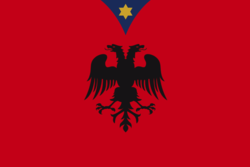Arbanasi (Albanian: Arbëreshët e Zarës, local dialect: Arbneshë), also known as the Arbëreshë of Zara, are a population in Croatia of Albanian origin, who speak a local dialect of Gheg Albanian.[1] Their name means Albanians in Croatian and is the toponymy of the first Arbanasi settlement in the region, which today is a suburb of Zadar.[2]
Distribution
Today, the community is spread across Croatia. Their original settlements were Arbanasi of Zadar and some villages around Zadar, namely Zemuniku, Dračevcu, Crnom, Ploce, etc.[2] The inhabitants of this one time village were known as the Arbanasi (or simply, the "Albanians" in Croatian). The Arbanasi are known to have settled the area during two different periods of migration; the first in 1726 and the second in 1733. These settlers were said to be part of the Kastrati clan, one of the numerous Northern Albanian clans known to have existed.[2]
History
The origin of this population is thought to be from Shkodra lake region in Northwestern Albania and Southeastern Montenegro. According to scholars they are descendants of immigrants from villages in Bar region of Montenegro primarely and from Shestan, Briska and Livar. Arbanasi have migrated in two different periods, during the 18th century.[2]
In August 1726 came the first group of 16 families for a total of 121 people, mostly wealthy peasants who had abandoned their possessions in order to escape Turkish oppression. A second installment came in 1727 and included seven families, totaling 71 people, who were initially housed in Zemunik, fraction of Zadar. The third group was the largest. They arrived in the village in 1733 and included 28 families with a total of 150 people.[3][4][5]
All these groups would be integrated into the social and economic Venetian-Dalmatian, but they preserved their language and their customs, and songs. First, the Albanian community worked to reclaim the marshy areas near the Arbanas, which was originally an island and that in time it was connected to the mainland, and then got to make the land cultivable land in the scheme of 'lease. The Venetian government took charge of construction of many homes and, at first, even meals.[3][4][5]
Since 1901 the Arbanasi was also equipped with an Albanian school and in 1910 James Vuxani promoted and organized the "Italo-Albanian Association".[3][4][5]
According to tradition, the Albanians of Arbanasi came from countries Briska and Sestan. These locations were identified by some with the villages of Shestan, Brisk, and Arbnesh Liar, all located in the hinterland of Bar and Ulqin in Montenegro, but within areas inhabited by Albanians. A demonstration of the fact that the origin of the Albanians of Arbanas were not located along the coast is that in their language most of the names of the fish comes from the Croatian.
After the Second World War, most of Arbanasi emigrated to Italy, following the fate of Zadar.[3][4][5]
